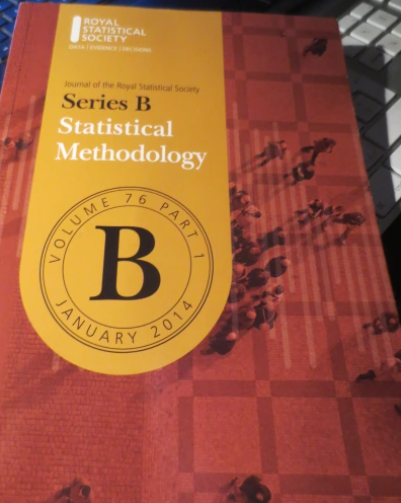归一化潜在测量因子模型
IF 3.6
1区 数学
Q1 STATISTICS & PROBABILITY
Journal of the Royal Statistical Society Series B-Statistical Methodology
Pub Date : 2023-06-23
DOI:10.1093/jrsssb/qkad062
引用次数: 0
摘要
摘要:我们提出了一种在贝叶斯非参数框架内建模和比较概率分布的方法。在依赖归一化随机测度的基础上,我们考虑离散随机测度集合的先验分布,其中每个测度是一组潜在测度的线性组合,可解释为不同分布共享的特征特征,具有正随机权重。提出了一种对后验样本进行后处理以实现识别推理的方法。利用黎曼优化来解决矩阵李群上的非平凡优化问题。我们的方法的有效性在模拟数据上得到了验证,并在两个实际数据集的两个应用中得到了验证:加州的学生考试成绩和个人收入。我们的方法对人群和容易解释的后验推理产生了有趣的见解。本文章由计算机程序翻译,如有差异,请以英文原文为准。
Normalised latent measure factor models
Abstract We propose a methodology for modelling and comparing probability distributions within a Bayesian nonparametric framework. Building on dependent normalised random measures, we consider a prior distribution for a collection of discrete random measures where each measure is a linear combination of a set of latent measures, interpretable as characteristic traits shared by different distributions, with positive random weights. The model is nonidentified and a method for postprocessing posterior samples to achieve identified inference is developed. This uses Riemannian optimisation to solve a nontrivial optimisation problem over a Lie group of matrices. The effectiveness of our approach is validated on simulated data and in two applications to two real-world data sets: school student test scores and personal incomes in California. Our approach leads to interesting insights for populations and easily interpretable posterior inference.
求助全文
通过发布文献求助,成功后即可免费获取论文全文。
去求助
来源期刊
CiteScore
8.80
自引率
0.00%
发文量
83
审稿时长
>12 weeks
期刊介绍:
Series B (Statistical Methodology) aims to publish high quality papers on the methodological aspects of statistics and data science more broadly. The objective of papers should be to contribute to the understanding of statistical methodology and/or to develop and improve statistical methods; any mathematical theory should be directed towards these aims. The kinds of contribution considered include descriptions of new methods of collecting or analysing data, with the underlying theory, an indication of the scope of application and preferably a real example. Also considered are comparisons, critical evaluations and new applications of existing methods, contributions to probability theory which have a clear practical bearing (including the formulation and analysis of stochastic models), statistical computation or simulation where original methodology is involved and original contributions to the foundations of statistical science. Reviews of methodological techniques are also considered. A paper, even if correct and well presented, is likely to be rejected if it only presents straightforward special cases of previously published work, if it is of mathematical interest only, if it is too long in relation to the importance of the new material that it contains or if it is dominated by computations or simulations of a routine nature.

 求助内容:
求助内容: 应助结果提醒方式:
应助结果提醒方式:


